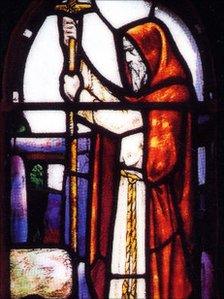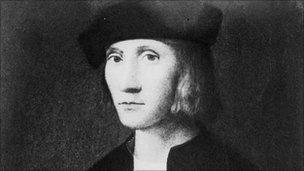Who was Saint Ninian?
- Published
Pope Benedict XVI arrives for his first visit to Britain on 16 September, which is St Ninian's Day.
The Pontiff's first destination is Edinburgh, where a St Ninian's Day parade will welcome him to the city.
But who exactly was Saint Ninian, and what was his historical significance?

Pilgrims continue to visit Ninian's tomb in Whithorn
The precise details of Ninian's life are disputed.
The Catholic Church described him as the man from south west Scotland "who first brought the Christian faith" to the country around 397AD, when he is said to have established a religious community at Whithorn in Galloway.
The church said Ninian studied in Rome before being ordained a bishop.
His monastery in the south of Scotland was known as Candida Casa, from the Latin meaning "White House". The name possibly refers to the stone used to construct it or the whitewash used to paint it, and has survived as the modern name, Whithorn.
It was from this base that he is said to have set about proclaiming the Gospel to the southern Picts.
The first historical reference to Ninian of Whithorn came from the Northumbrian scholar and monk Bede, in his Ecclesiastical History of the English People, written around 731.
'Traditional' information
He described him as a Briton who was instructed in Rome and noted that his church was made of stone, which was unusual at the time.
Bede said Ninian named his episcopal see after Saint Martin of Tours, although other accounts claim he actually met the French patron saint on his return to Scotland.
The historian conceded he was only passing on "traditional" information in his brief reference to Ninian, and does not claim it is factual.
In the 12th Century, Aelred, the abbot of Rievaulx in Yorkshire, wrote A Life of Saint Ninian - thought to be at the behest of one of the new bishops of Galloway, who was eager to promote their bishopric to the wider world.

King James IV's devotion to Ninian enhanced his reputation with fellow Scots and the wider Church
Aelred attributed 10 miracles to Ninian, six during the saint's lifetime and four after his death.
Whatever the truth of Ninian's life, over the centuries his tomb at Whithorn became one of the centres of Christian pilgrimage.
It was also an important place of worship for the Scots royal family. In the 14th Century it is said a dying King Robert the Bruce went there to pray for a cure from leprosy.
Two centuries later, King James IV spent eight days walking to the shrine, and is said to have distributed money to the poor as he travelled.
When the visit of Pope Benedict was confirmed, Scotland's most senior Catholic, Cardinal Keith Patrick O'Brien, said he wanted to resurrect the festivities that used to surround St Ninian's Day.
He suggested organising "a grand Scottish spectacle to welcome Benedict XVI".
This spectacle will be the St Ninian's Day Parade, where more than 1,000 pipers will play as the Pope travels through the Scottish capital.
Hundreds of children from the 14 Scottish schools named after St Ninian, including Episcopalian and non-denominational schools, will take part.
- Published31 August 2010